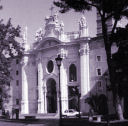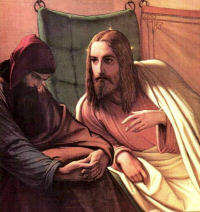Lent: March 19th
Fourth Sunday of Lent
Other Titles: Laetare Sunday
Free eBook:

|
| Free eBook: Liturgical Year 2023-2024, Vol. 4 |
» Enjoy our Liturgical Seasons series of e-books!
Today is the halfway mark of the Sundays of Lent. This Sunday is known as Laetare Sunday for the first word of the Introit or Entrance Antiphon laetare (rejoice); it is a Sunday of joy. The celebrant has the option to wear rose-colored vestments. This is also the Second Scrutiny in preparation for the baptism of adults at the Easter Vigil.
The Church’s liturgy, on this the Fourth Sunday of Lent, invites us to retrace one of the fundamental dynamics of our baptismal re-birth through the Gospel account of the healing of the ‘man born blind’. It is the passage from the darkness of sin and error to the Light of God, who is the Risen Christ.
The Solemnity of St. Joseph is usually celebrated on March 19, but has been transferred to March 20 since the liturgy of the Lenten Sundays take precedence.
Meditation on the Liturgy
This Sunday has a place apart amongst the Sundays of Lent. As in Advent we had Gaudete Sunday, so in Lent we have a Sunday commonly called Laetare Sunday. The whole week, with its wealth of liturgical significance, is intensely interesting. This Sunday in vigesimal is in imitation of Byzantine custom, a Sunday in honor of Our Saviour's Cross, for which reason the Station is at Holy-Cross-in-Jersualem, a great devotional centre in Rome, especially during Passiontide. The great part of the Mass is inspired by this choice.
Lent is half over, and Easter is enticingly near. This Sunday is our foretaste of Easter joy. Knowing the ebb and flow of intensity even in our best efforts, God deals with us tenderly in rhythms of consolation and desertion. So today, thoughts of freedom and joy come in the middle of Lent. But the joy does more than cushion our failing energies and needle our lagging spirits. It is a positive, meaningful joy, born of our fruitful life in Christ and of our sweet freedom as His purchased children. The Eucharistic banquet of heavenly Bread, foreshadowed by the multiplied loaves and fishes and become now the Bread of Life for the whole Christian world, adds to our Laetare joy the quiet gladness of every festive meal.
Sunday Mass Readings, Cycle A:
The First Reading, from the first Book of Samuel 16:1b, 6-7, 10-13a, contains, at best, oblique references to the other two readings. The anointing of David as king may be a reference to the anointing in the responsorial psalm both of which may refer to Christ the good shepherd. The figure of David may also be a prefigurement of the anointing to Messiahship of Jesus for his mission. Whatever the reason for its selection for this day, the theme of the liturgy is better reflected in the other two readings for they present implications and applications of the baptism of the believer.
The Second Reading from the Letter of St. Paul to the Ephesians 5:8-14 is particularly significant because throughout the season of Lent the community has been urged to cast aside deeds of darkness and walk in the brilliance of the light of Christ. In this reading, for the first time during Lent, the darkness-light theme which will be so predominant at Easter is enunciated. The believer must leave the deeds of darkness and live according to the justice and truth of God through the light of Christ. The selection of this reading for the Sunday liturgy of the second scrutiny emphasizes clearly that the preparation of a person coming to the faith is one of moral formation as well as in-formation about the faith. The preparation of adults to be baptized has more to do with choices and deeds than it does with dogmatic teaching.
The Gospel reading from John 9:1-41, dominates the liturgy by the length of the reading and its significance. Already, in Old Testament Revelation, the Lord God had shown the People of Israel how the justice of the Creator was so much more profound and true that the thoughts of men. We have, in fact, heard in the first reading ‘God does not see as human beings see; they look at appearances but the Lord looks at the heart.' (1 Sam 16:76). The Lord pointed out in this way the true, unique, criteria on which men are judged. He also indicated the unique place in which man can meet God’s gaze and enter into a relationship with Him—in his heart. Obviously, by the word ‘heart’ the Bible doesn’t mean the centre of pulsation, but man’s ‘shrine’, his conscience where he can really listen and recognise God’s voice and so benefit from the Light: ‘for the effects of the light are seen in complete goodness and uprightness and truth’. (Eph 5:9)
Man, incapable of remaining faithful to the truth that is in him, falls back to his own limited criteria. This criteria produces every malice, injustice and falsehood and is used to govern himself, to decide between good and evil, whilst hoping that what he obtains will be to his benefit and so in this way he acts ‘like God’ (Gen 3:5).
God doesn’t give up but comes to meet everyone of us in the two fold way described in today’s Gospel. Firstly, ‘he spat on the ground and made clay with the saliva, and smeared the clay on his eyes’ (Jn 9:6). God made man, who is a creature. He united Himself to ‘our earth’ so that man would never need to flee Him, but could come to recognise Him through a meeting with His Holy Humanity. St. John wrote in the Prologue to his Gospel, ‘The Word became flesh, he lived among us’ (Jn 1:14).
In the second place from the Gospel account we read, ’He said to him, “Go wash in the Pool of Siloam”—which means Sent—‘. (Jn 9:7a). Christ, sent by the Father, takes onto Himself all our sins, which are ultimately the consequences of our blindness, as far as allowing Himself to be stripped, crowned with thorns, nailed to the cross, rejected by His own people and abandoned by His closest friends. Christ’s unprecedented love can’t but definitively overcome, with time, every fear in the face of our limitations because there isn’t anything that can stop Him from loving us. From the loving assumption of our rejection to our obtuseness murder, the Lord has worked extraordinary feats in history. He frequently offered His Body to the Father for our salvation and therefore has consecrated His entire Person for every one of us. He has introduced us into His Most Holy Heart, inflamed with love for us, which is the same as God’s light. In the Light of the Resurrection he made us a ‘new creation’ (cfr 2 Cor 5:17) and in the Gospel account we have heard ‘he went and washed, and came back able to see’. (Jn 9:7)
The indestructible link with Christ, which is founded on His love and fidelity, is the ‘new creation’ that was given to us on the day of our Baptism. Through the Sacraments of Christian initiation we are more profoundly linked with Christ. This ‘new creation’ can not bring fourth fruit in us without the full and renewed consent of our liberty that, in this earthly life, is expressed, reinvigorated and triumphs through the extraordinary events that Christ works in our lives. The blind man was interrogated by the world as to the precise details of his cure and with great simplicity he explained what happened to him: ‘The man called Jesus made clay and anointed my eyes and told me, ‘Go to Siloam and wash.’ So I went there and washed and was able to see.”’ (Jn 9:11)
Let us ask Most Holy Mary to help us to be faithful to the truth, to the events of our lives, taking the hand that always takes us to live totally for Him, in this life and eternity. ‘Wake up, sleeper, rise from the dead, and Christ will shine on you.’ (Eph 5:14).
—From the Congregation for the Clergy

Fourth Sunday in Lent (Laetare Sunday)
Station with Santa Croce in Gerusalemme (Holy Cross In Jerusalem):
This church is one of the seven pilgrim churches in Rome. St. Helen, mother of the emperor Constantine, had a church built in Rome to house the relics of the Passion of Our Lord which she had obtained during her pilgrimage to the Holy Land. St. Helen discovered the true Cross of Our Savior with its title and the instruments of His death such as the nails and the crown of thorns. She had the top layer from Mount Calvary removed and placed in barges that carried this material to Rome. She then had the builders use this soil as the ground on which she had the basilica built for the sacred relics. The true Cross and other holy items have been kept in this basilica since its consecration in the fourth century and can be visited to this day. Because of the great relic enshrined there, the basilica is called the Holy Cross and because it is built on the soil from Mount Calvary it is said to be in Jerusalem.
For more on Santa Croce in Gerusalemme, see:
For further information on the Station Churches, see The Stational Church.







